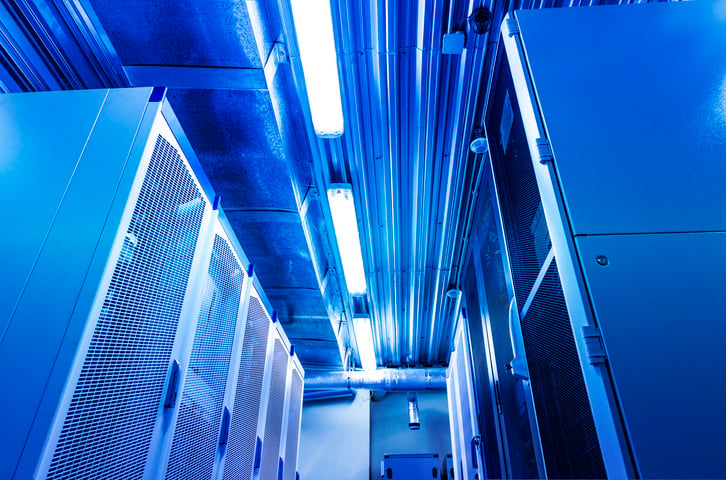Data Center Design Standards: Ensuring Efficiency and Compliance

Data centers are the engines of the digital age, powering everything from e-commerce to telemedicine and entertainment.
These massive facilities handle immense data volumes, but their operational demands come with significant environmental and energy costs. Addressing these challenges requires adhering to data center design standards — frameworks that ensure safety, reliability, and sustainability.
Central to these standards are advanced sensor technologies, particularly temperature, humidity, and airflow sensors. These devices provide the insights needed to optimize energy consumption, enhance cooling efficiency, and comply with stringent data center regulations.
Why Are Data Center Design Standards Important?
Data center design standards are more than just a suggestion; they’re essential for several reasons:
-
Energy & environmental impact: Data centers are notorious energy eaters, with some facilities using as much electricity as small towns. The immense power required to run servers and cooling systems contributes significantly to environmental concerns, including carbon emissions and resource depletion.
-
Safety: Proper design standards minimize the risk of fires, electrical hazards, and environmental damage caused by leaks or equipment failures.
-
Reliability: Downtime in a data center can be catastrophic, leading to data loss, financial repercussions, and a bad reputation. Data center design standards emphasize redundancy, robust infrastructure, and reliable cooling systems to ensure continuous operation and protection of critical data.
-
Efficiency: Optimizing energy consumption and resource usage is a core objective of data center design guidelines. Efficient cooling systems, strategic sensor placement, and intelligent power management contribute to reduced operational costs and improved performance.
-
Regulatory compliance: Meeting local, state, and national requirements is non-negotiable for operators. Compliance with data center government regulations avoids legal penalties and enhances the organization’s reputation as responsible and forward-thinking.
Key Data Center Design Standards and Regulations
Data centers are subject to several design standards and regulations to ensure optimal performance, reliability, and safety. These guidelines cover various aspects of data center infrastructure, including power distribution, cooling systems, fire protection, and security.
Here’s a breakdown of some key design standards and regulations that impact data center operations and how sensor technology plays a vital role:
ASHRAE Data Center Standards
The American Society of Heating, Refrigerating, and Air-Conditioning Engineers (ASHRAE) sets the benchmark for data center cooling and energy efficiency. ASHRAE data center design guidelines promote efficient cooling methods like hot aisle/cold aisle configurations and liquid cooling technologies.
Two key standards are particularly influential:
-
-
Recommends optimal temperature and humidity ranges to prevent equipment failure and reduce energy waste.
-
Specifies sensor placement, including three temperature sensors per rack (top, middle, bottom) and strategic humidity sensors for accurate monitoring and efficient cooling.
-
Indirect Influence: While not explicitly stated, space pressures and filter differential pressures can indirectly influence energy consumption:
-
Proper Pressurization: Maintaining appropriate pressure relationships between different zones (e.g., cold aisle vs. hot aisle) improves cooling system effectiveness and reduces energy waste.
-
Filter Performance: Clean filters with appropriate differential pressures ensure optimal airflow and minimize fan energy consumption.
-
-
-
-
Focuses on energy-efficient cooling, such as airflow containment and liquid cooling, requiring temperature and airflow sensors to maintain system efficiency.
-
Encourages dynamic environmental monitoring using real-time sensor data to optimize cooling and energy use.
-
NFPA 75 & NFPA 76: Fire Protection Standards
Proper fire protection is critical for maintaining uptime and preventing catastrophic losses. Implementing fire protection systems — including smoke detectors and temperature and vibration sensors in server racks — ensures early detection and response to potential hazards. Sensors monitor environmental changes, such as temperature spikes or smoke, triggering early warning systems to prevent catastrophic losses.
The National Fire Protection Association (NFPA) sets critical fire safety standards for data centers:
-
NFPA 75: This standard mandates using early warning systems, including smoke detectors and temperature and vibration sensors in server racks. These sensors are crucial to detecting fire hazards early, allowing for timely response and minimizing damage.
-
NFPA 76: This standard addresses the electrical safety of telecommunications facilities, including data centers. This standard requires sensors to monitor environmental conditions, such as temperature and humidity. By monitoring these parameters, data centers can prevent electrical failures and other hazards leading to fires or equipment damage.
ANSI/TIA-942: Data Center Infrastructure Standards
The Telecommunications Industry Association (TIA) partnered with the American National Standards Institute (ANSI) to develop ANSI/TIA-942. This standard is a globally recognized guide to building efficient, reliable, and scalable data centers.
Key areas where sensors contribute include:
-
Redundancy and Reliability: Temperature and airflow sensors support fault-tolerant designs by ensuring backup systems operate effectively.
-
Energy Efficiency: Sensors facilitate compliance with energy efficiency metrics such as Power Usage Effectiveness (PUE), a key focus of ANSI/TIA-942.
-
Environmental Monitoring: Continuous data ensures compliance with environmental requirements.
-
Scalability: Real-time monitoring supports modular, adaptable systems.
California Title 24: Energy Efficiency Regulations
California’s Title 24 energy regulations are among the strictest in the U.S., requiring advanced monitoring systems to optimize HVAC and lighting.
Sensors are needed to comply with Title 24’s energy efficiency requirements in data centers:
-
Airflow Management: Airflow sensors optimize cooling and prevent hot/cold air mixing.
-
Cooling Efficiency: Temperature and humidity sensors ensure efficient cooling operation.
-
PUE Compliance: Sensors track energy use to meet Power Usage Effectiveness (PUE) targets.
-
Dynamic Adjustments: Real-time sensor data reduces unnecessary HVAC energy use.
FEMP Best Practices for Data Center Design
The Federal Energy Management Program (FEMP) provides guidelines for federal facilities on designing energy-efficient data centers. Sensors provide real-time insights that enable data centers to fine-tune operations and maximize efficiency.
FEMP directly ties to sensor use by emphasizing energy efficiency and environmental responsibility in federal facilities:
-
Energy Efficiency: Sensors monitor temperature, humidity, and airflow to optimize cooling and improve Power Usage Effectiveness (PUE).
-
Dynamic Power Management: Real-time data enables systems to reduce energy use during low-demand periods.
-
Environmental Monitoring: Sensors ensure optimal conditions while minimizing energy waste.
-
Compliance: Sensors support adherence to FEMP guidelines for sustainable operations.
EN 50600: European Data Center Standard
EN 50600 indirectly supports using sensors by focusing on energy efficiency, sustainability, and reliability in data centers. While the standard does not mandate specific sensors, they are essential tools for achieving compliance with its guidelines.
-
Energy Efficiency: Sensors monitor temperature, humidity, and airflow, optimizing cooling strategies and improving Power Usage Effectiveness (PUE).
-
Environmental Sustainability: Real-time sensor data helps minimize energy waste, track carbon footprints, and maintain optimal operating conditions.
-
Reliability: Sensors enable early detection of issues like overheating or airflow blockages, ensuring system uptime and predictive maintenance.
-
Modularity and Scalability: Sensors support modular cooling and seamless upgrades by adapting to real-time environmental data.
ISO 14001: Environmental Management Systems
ISO 14000 aligns closely with the use of sensors by emphasizing environmental monitoring and resource optimization. While it doesn't mandate specific sensors, they are essential for achieving its goals:
-
Energy Efficiency: Sensors monitor temperature, airflow, and humidity to optimize cooling and reduce energy waste.
-
Sustainability: Real-time data from sensors helps track energy use, emissions, and water consumption for compliance and sustainability.
-
Continuous Improvement: Sensors provide insights for ongoing enhancements in environmental performance.
-
Risk Management: Early detection of inefficiencies or overheating helps prevent excessive resource use and environmental harm.
Energy Efficiency and Sustainability in Data Center Design
As the demand for digital services grows, so do the expectations for data center efficiency and compliance with data center environmental regulations. Sensor technology is at the forefront of enabling data centers to meet these challenges. By providing real-time insights into environmental conditions, sensors empower operators to optimize cooling, reduce energy consumption, and maintain adherence to data center government regulations.
Amphenol Advanced Sensors: Your Partner in Compliance
We recognize that you’re walking an intricate balance between performance, compliance, and sustainability. Our advanced sensing solutions provide accurate, real-time data on critical parameters like temperature, humidity, and airflow. This precise monitoring enables your data center to fine-tune its cooling systems, optimize energy consumption, and maintain ideal operating conditions—all while meeting stringent regulatory requirements.
Explore how Amphenol Advanced Sensors can help your data center achieve compliance, optimize energy efficiency, and drive sustainability:




